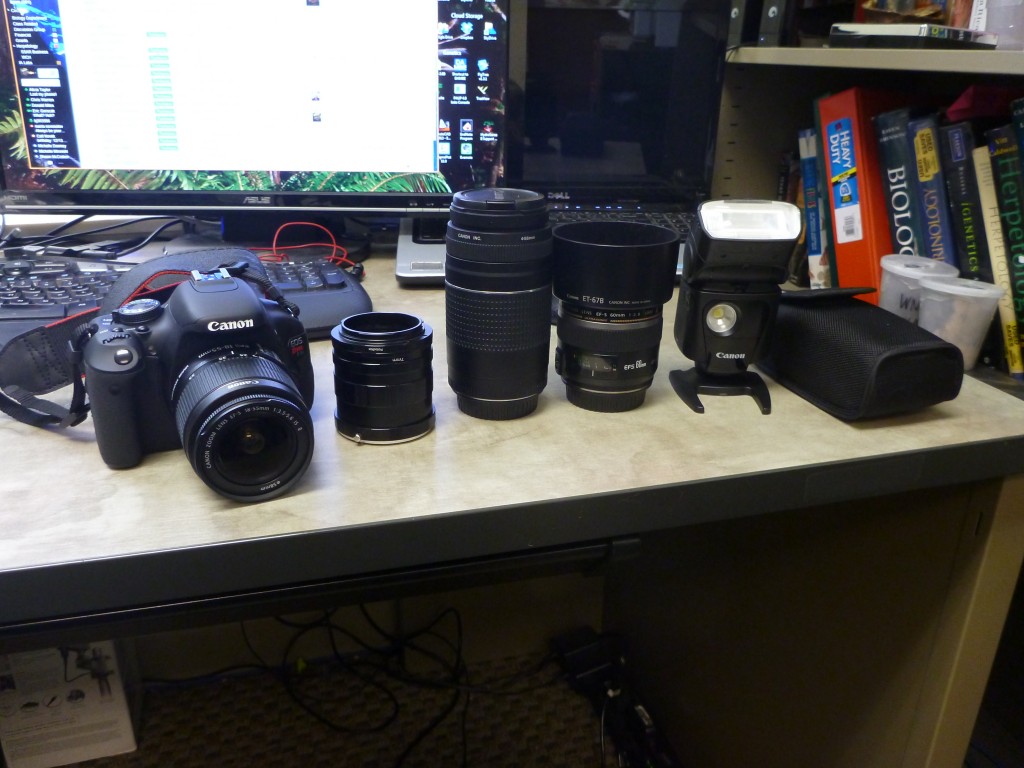Let the photo documentation begin!
If you have ever been with me while I am traveling or doing field work you know I like taking photos. It started in Australia with me documenting my travels and partying adventures. I have thousands of photos from that trips, mostly of the wonderful people I met there. However, Australia was one of the rare time I actually took photos of people as I tend to focus on wildlife. Finding a box turtle or little salamander in the woods might be an interesting 5 second encounter for most people, but for me, and many herpers, it becomes 10+ minute attempt to get a good photograph. Photographing wildlife can be very challenging. Mammals and birds typically require an expensive telephoto lens and/or a lot of patience. Smaller creatures like insects or my favorites, reptiles and amphibians, require less expensive equipment to get a good shot, but it certainly doesn’t hurt if you have some good gear. Smaller creatures also require some self control. Twenty minutes for a photographer may not be a big deal, but the stress it puts on the animal can be fatal. So sometimes you just need to know when to say enough is enough and except the photos you have.
I have had a variety of cameras over the years. I have typically purchased Canon cameras, one because I have built up a collection of lens which only fit Canon cameras, and second I have always liked the quality of the photos they have produced which has given me no reason to want to switch to another company. The only non-Canon camera I own is a Panasonic Lumix which is mostly for field work. It is water and dust proof and can handle up to a 2 meter drop. However, I have found that I really like using a SLR camera over the easy to use point and shoot. My first real use of an SLR camera was one of Canon’s first digital versions made for amateurs, the Canon XT. I purchased this camera almost 7 years ago. The XT still works but has some technical issues that make it pretty difficult to use for wildlife photography. Given it has been almost 7 years and the technology has improved I was thinking it might be time to upgrade. I did not have the money available for one at this time, but luckily my lovely mother gave me a surprise this Christmas with a new Canon T3i.
I wont bore you with all the details about the camera, but I will point out some great features that will help my amphibian photography. As my project deals with salamanders I anticipate taking thousands of photos of them over the next two years. However, salamanders are surprisingly difficult to photograph. They move a lot and also have a very wet sheen making the built in flash of most cameras pretty useless. Unfortunately, salamanders love dark places making the use of a flash a must! The Canon T3i helps prevent some of these problems. The biggest plus in my book is the wireless flash capabilities built into the camera. This allows me to use an external flash from multiple angles. I purchased a 320EX flash to go along with the camera. This external flash includes a constant LED light for videos and also allows me to trigger the camera remotely Which means I can setup the camera and hold the flash from a different position and still take a picture. The camera also comes with a nice EFS 18-55mm lens with a built in image stabilizer. Using a tripod with salamanders is not ideal, but it is also really hard to get a good depth of field without closing the aperture. The image stabilizer will let me free hand shoots with a small aperture and still get clear photos. The camera also has other great features such as an HD movie mode and a flip out LCD screen, both of which are major improvement over my original XT.
Right now I have a good camera setup with the Canon T3i digital SLR, Fotodiox Extension tubes, EF 75-300mm 1:4-5.6 III USM telephoto lens, fixed EF-S 60mm 1:2.8 USM macro lens, EFS 18-55mm Immage stabalized macro lens, 320EX Speedlite External Flash, and a set of Tiffen lens filters. I am excited to get out and use them this spring!

